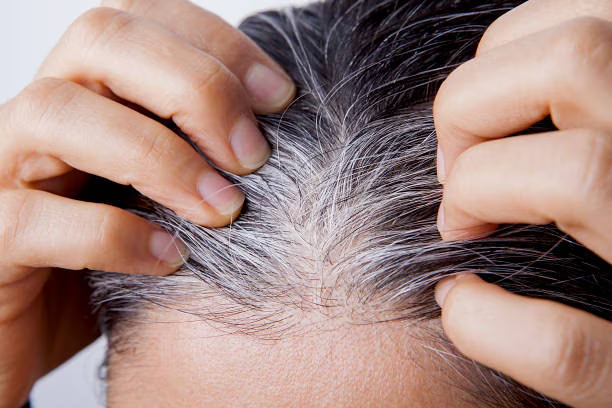“Understanding White Hair: The Top Causes and How to Prevent It”
Introduction
White hair is a common concern for many people, often seen as a sign of aging or stress. But did you know that various factors can cause white hair to appear earlier than expected? From genetics to lifestyle choices, understanding these causes can help you take proactive steps to manage and prevent it. In this blog post, we’ll dive into the top reasons behind white hair and share practical tips for prevention. For more detailed insights, check out wellhealthorganic.com/know-the-causes-of-white-hair-and-easy-ways-to-prevent-it-naturally. Let’s explore how you can maintain your natural hair color and promote overall hair health!
What is “Understanding White Hair: The Top Causes and How to Prevent It”?
“Understanding White Hair: The Top Causes and How to Prevent It” is a comprehensive exploration of why white hair occurs and how you can address it. This topic delves into the underlying reasons behind the graying of hair, which can include natural aging, genetic factors, nutritional deficiencies, and lifestyle influences like stress and smoking.
In this context, the goal is to provide a clear and accessible overview of:
Causes: Identifying the primary reasons why hair turns white, such as the reduction of melanin production, genetic predispositions, and health conditions.
Prevention Strategies: Offering practical advice on how to potentially delay or prevent white hair through dietary changes, stress management, and proper hair care.
Why is Understanding White Hair Important?
Understanding white hair is crucial for several reasons, both from a health and aesthetic perspective. Here’s why:
1. Aging and Self-Perception
Aging Process: White hair is often associated with aging. Knowing the factors that contribute to its appearance can help individuals better understand and accept the natural aging process.
Self-Esteem: Early or unexpected graying can affect self-esteem. Understanding its causes allows people to address their concerns and potentially manage their appearance in ways that align with their personal preferences.
2. Health Implications
Nutritional Deficiencies: White hair can sometimes signal deficiencies in essential nutrients such as Vitamin B12, iron, and copper. Identifying these deficiencies helps in making dietary adjustments to improve overall health.
Underlying Conditions: Premature graying might be linked to certain health conditions like autoimmune diseases or thyroid disorders. Understanding these connections encourages timely medical consultations and interventions.
3. Prevention and Management
Lifestyle Adjustments: By learning about the causes of white hair, individuals can adopt lifestyle changes to potentially slow down or prevent its onset. This includes managing stress, quitting smoking, and improving diet.
Hair Care: Knowledge of how to care for hair properly can help in maintaining its health and appearance, minimizing damage that could contribute to premature graying.
4. Informed Decisions
Treatment Options: Understanding the causes of white hair enables individuals to make informed decisions about treatments or products they may use to address or conceal white hair.
Personalized Approach: With the right knowledge, people can choose prevention strategies that best suit their unique situation and preferences, leading to more effective and satisfying results.
Step-by-Step Guide: Understanding White Hair and How to Prevent It
Step 1: Identify the Causes of White Hair
Genetics
Review your family history to understand if early graying is a common trait. Genetics play a significant role in when and how much white hair you might experience.
Aging
Accept that aging is a natural process that affects melanin production in hair follicles, leading to white hair.
Nutritional Deficiencies
Assess your diet for potential deficiencies in key nutrients such as Vitamin B12, iron, and copper. Consider getting a blood test if you suspect deficiencies.
Stress
Reflect on your stress levels and consider how they might be impacting your hair. Research the connection between stress and white hair to better understand this factor.
Health Conditions
Be aware of any symptoms related to autoimmune diseases or thyroid disorders that could be contributing to white hair. Consult with a healthcare professional for proper diagnosis and treatment.
Smoking
If you smoke, acknowledge its potential impact on early graying. Explore resources and strategies to quit smoking.
Step 2: Implement Prevention Strategies
Adopt a Healthy Diet
Incorporate foods rich in Vitamin B12, iron, and copper into your diet. Examples include leafy greens, nuts, seeds, and lean meats.
Consider consulting a nutritionist to create a balanced meal plan that supports hair health.
Manage Stress
Engage in stress-reducing activities such as yoga, meditation, or regular exercise.
Identify stress triggers and develop coping strategies to minimize their impact on your life.
Practice Proper Hair Care
Use gentle hair care products that nourish and protect your hair. Avoid excessive heat treatments and harsh chemicals.
Regularly condition your hair and avoid over-washing to maintain its health and vitality.
Schedule Regular Health Check-ups
Schedule routine medical check-ups to monitor overall health and catch any potential issues early.
Discuss any concerns about premature graying with your doctor during visits.
Quit Smoking
If you smoke, take steps to quit. Seek support from smoking cessation programs or consult a healthcare provider for help.
Replace smoking with healthier habits like exercise or hobbies to improve overall well-being.
Step 3: Explore Treatment Options
Consult with a Professional
Action: If you’re considering treatments to manage or conceal white hair, consult with a dermatologist or trichologist for personalized advice.
Discuss the pros and cons of various treatments, such as hair dyes or supplements.
Try Natural Remedies
Explore natural remedies that may help in managing white hair, such as herbal treatments or essential oils.
Ensure any natural remedies are safe and tested before use.
Step 4: Stay Informed and Adapt
Keep Up with New Research
Stay updated on the latest research and advancements related to hair health and white hair prevention.
Follow reputable sources and health blogs for new information and tips.
Adapt Strategies as Needed
Adjust your prevention and treatment strategies based on your individual needs and any new information you acquire.
Regularly review and update your approach to ensure it remains effective.
Conclusion
Understanding why white hair occurs and how to prevent it can help you take control of your hair health. By knowing the causes—whether it’s genetics, aging, nutritional deficiencies, stress, or smoking—you can make informed choices to manage or delay white hair. Adopting a healthy diet, managing stress, and proper hair care are key steps in prevention. For additional tips and natural ways to keep your hair looking its best, check out wellhealthorganic.com/know-the-causes-of-white-hair-and-easy-ways-to-prevent-it-naturally. Take these steps to maintain your natural hair color and enjoy healthy, vibrant hair!






